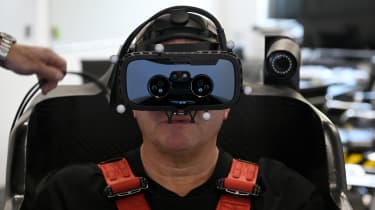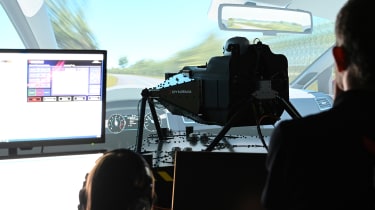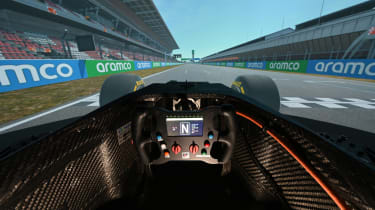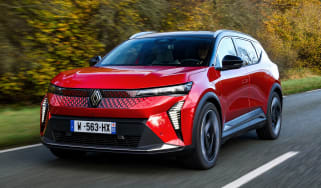The world's best car simulator: we get behind the wheel
Dynisma’s driving simulator is so advanced that it could eventually replace conventional car development and testing. We head to the firm’s Bristol HQ to jump into the driving seat
How fast can you think? It’s generally accepted by science that it takes around 50 milliseconds – one 20th of a second – for our brains to process sensory stimulation when it’s presented to us randomly, and to then respond. In other words, to experience something we’re not expecting and then to think about it.
To put that into context, sound will travel 17 metres and a housefly will flap its wings around 150 times in 50 milliseconds. Yet the blink of a human eye takes approximately 100 milliseconds, which in theory means we can think twice as fast as we can blink.
But when we’re expecting something to happen, we can receive and respond to information much faster than this, because our brains are already primed to do so. Then, scientists believe, we can process information in around a quarter of a millisecond, during which time sound travels just 8.5cm and a fly will appear as if on freeze frame, mid-air, because it doesn’t flap its wings so much as once.
So if the simulation of an event has any chance of appearing real to us, the speed with which it’s delivered – not just to our brains but also to our hands, backside, ears, eyes, nose, you name it – is crucial and needs to be very fast indeed. If the sensory experience being relayed is in any way out of sync with our brains, or isn’t delivered fast enough, it won’t appear realistic. But if it is – if a simulator can deliver sensations at the same speeds and rhythms as our noggins process them – then it can, and will, appear very real indeed.
Which is why the work being done by the team behind the world’s fastest and most authentic driving simulator at Dynisma on the outskirts of Bristol, is in such high demand. Not just by racing teams such as Ferrari, who co-founder Ash Warne used to work for, but also by major car companies. They have realised that ‘authentic simulation’ can play an increasingly key part in road-car development, one that can potentially save them huge sums by cutting down on testing costs, and produce better cars at the same time. Simulation therefore is a major piece of tech to have up your sleeve – if it works.
At a stroke, the idea of having to build prototypes could theoretically be rendered obsolete by Dynisma’s simulators. The testing and verification parts of a road car’s development could in theory go all the way up to production eventually, which will enable brands to save gigantic sums of cash, so long as the simulation is ‘authentic.’ Because if it isn’t – if the simulation feels like no more than a pumped-up games console ultimately – then real-time development of road and racing cars will still be required. Question is, can a driving simulator ever be that real?
We’re not quite there just yet, for although Warne and his 50-strong team at Dynisma know they’re getting very close to offering a fully authentic driving experience, even they admit that, for the time being, we can still think a tiny bit faster than a simulator can perform. But only just.
The Dynisma sim’s “latency” – its operating speed – is between three and five milliseconds, so it appears very real most of the time, but not all of the time. For the foreseeable future, this means real-time testing is still needed to verify the legwork that can undeniably be done in its simulator.
Even so, Dynisma’s sim is still currently the world’s fastest-responding one right now. The only other that comes close to matching its speed – and therefore its reality – is the one used by the Ferrari F1 team. But this was built for Ferrari by Dynisma, so at the moment this really is the cutting edge.
How real does the Dynisma sim feel, and does it honestly come close to replicating an actual driving experience? The answer is very, and yes it does – to a point where having spent the morning in it driving a 2019-spec F1 car around Spa and, more intriguingly, a BMW on the roads of Warwickshire, I climb out of it, get into my real BMW and actually have to briefly stop at the side of the road to remind myself that I am back in the real world.
Unlike some sims, the Dynisma doesn’t have a vast range of physical movement to it, the system instead delivering small but ultra-fast movements to its cockpit via a series of horizontal ‘tracks’ with vertical ‘dampers’ to produce the most unbelievably real sensations.
You need to don a crash helmet to get the full effect, and I find the simulations most authentic when wearing FPV (first person view) goggles, rather than looking at the enormous wraparound screen. But one of the issues with sim ‘driving’ is that it can make some people feel nauseous, an effect that’s amplified when using the goggles.
Yet it’s the reality of the sim’s responses to things such as kerbs and even the smallest changes in camber and road surface quality that are the most impressive aspects to experience, but also the most perplexing. When driving a BMW 1 Series in the sim on the public roads near to the JLR and Aston Martin HQs in Warwickshire – roads I know pretty well – it only takes a minute or so to feel entirely immersed in the experience. My brain is telling me that everything around me is real. At the same time my backside, hands, ears and eyes are being tickled realistically enough for me to begin thinking I am actually there, driving the BMW.
When I ask for the car to be put into Sport mode, having been in Comfort, then drive across the exact same roads, the reality of the experience goes to another level again.
All it takes is a new piece of software to be loaded and the 1 Series immediately feels slightly stiffer, slightly sharper in its general responses, its steering gets a touch heavier and the car feels lighter on its feet. It even makes a slightly sportier noise, I think. Just as it does in reality when you press Sport in a BMW 1 Series.
At this point the penny drops. If the firm can accurately simulate changes in a car’s behaviour that are as nuanced as this, I realise, the sky’s the limit as to what you can test and verify in a sim as authentic as Dynisma’s. You could try out endless damper, spring or diff settings to see if they work or not. That can be extended to gearbox or engine map settings or entire chassis set-ups.
Complete vehicles can be designed on computers, then tested in sims like this, the less good ones being discarded and only the very best cars going on to get made. All the testing will have been carried out within the confines of just one, albeit fairly big room, such as the one at Dynisma.
When I climb out and tell them how stupefyingly real their simulator is, it’s not surprising to clock the raw enthusiasm in Warne’s and Dynisma’s commercial director, Jason Baker’s eyes. They know what they’re sitting on here, and it’s a gold mine. They then explain how anything from ride and NVH, to entire in-car HMi systems, to aerodynamics or a vehicle’s all-round visibility can be experienced and perfected in their sims.
Yes, racing cars can also be designed and tested endlessly to see if they go faster or slower with different suspension sets ups, different diff maps, at different circuits, even in different kinds of weather. Hence the reason the Ferrari F1 has its Dynisma simulator in use 24/7 at Maranello right now.
But it’s the road-car development that’s potentially the biggest game changer of all. That’s why Warne and his team already have two and four-seater sims being built, ones that will be able to replicate the experience of driving – and being driven in – anything from a sports car to an SUV or a saloon. Or a van. Or a lorry. You name it, Dynisma will be able to simulate the driving experience, and the more sims they build for vehicle manufacturers, the better they will get at it. And they’re already pretty damn good.
Don't miss our next car video, subscribe to our YouTube channel today...








